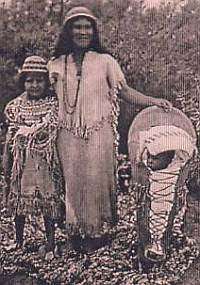Southern Paiute people

The Southern Paiute people is a tribe of Native Americans that have lived in the Colorado River basin of southern Nevada, northern Arizona, and southern Utah. Bands of Southern Paiute live in scattered locations throughout this territory and have been granted federal recognition on several reservations.
The first European contact with the Southern Paiute occurred in 1776, when fathers Silvestre Vélez de Escalante and Francisco Atanasio Domínguez encountered them during an attempt to find an overland route to the missions of California. They noted that some of the Southern Paiute men "had thick beards and were thought to look more in appearance like Spanish men than native Americans".[lower-alpha 1] Before this date, the Southern Paiute suffered slave raids by the Navajo and the Ute. The arrival of Spanish and later Euro-American explorers into their territory increased slave raiding by other tribes. In 1851, Mormon settlers strategically occupied Paiute water sources, which created a dependency relationship. But, the presence of Mormon settlers soon ended the slave raids, and relations between the Paiutes and the Mormons were basically peaceful. The Mormon missionary Jacob Hamblin worked at diplomatic efforts. The introduction of European settlers and agricultural practices (most especially large herds of cattle) made it difficult for the Southern Paiute to continue their traditional lifestyle, as it drove away the game and reduced their ability to hunt, as well as to gather natural foods.
Today Southern Paiute communities are located at Las Vegas, Pahrump, and Moapa, in Nevada; Cedar City, Kanosh, Koosharem, Shivwits, and Indian Peaks, in Utah; at Kaibab and Willow Springs, in Arizona.
Traditional Southern Paiute bands
The Southern Paiute traditionally had 16 to 31 subgroups, bands, or tribes.[1]
- Ankakkani'kacimi (Un-ka-ka'-ni-guts, Unka-kanig-its, Oaw'tuhus'eng), "Yellow Mouth of Canyon People" in present Long Valley
- Antarianunts (Ute name with ending unts); Paiute name Yantar
ii, mixed Southern Paiute-Ute band from Escalante River east to Colorado River and southeast to Henry Mountains, Utah[1] - Beaver band (Kwi?umpací
ii, Kwiumpus, Quiumputs), "Frasera speciosa people", lived in Beaver Valley along Beaver River near today's Beaver, Utah,[1] some intermarried with the Pahvant Ute band to the north living in the deserts near Sevier Lake - Cedar band (Ankappanukkic
icimi), Unkapanukuints, "Red-stream people", or Suh’dutsing, "Cedar people" from near Cedar City, Utah[1] - Gunlock band (Matooshats, Matissatï was the name given them by the southwards living St. George band/Uainuints, they instead bestowed the term to Southern Paiute bands northeast of them), lived near Gunlock[2] in southwest Utah
- Kaibab (Kaipapic
icimi, Kaivavwits, Kaibabits, Kaipa'pici, Kaivavituvingui, "Mountain Lying Down People" the Kaibab Plateau and Kaibab National Forest in northern Arizona are named after them[2] - Indian Peak Band
- Kaiparowits, "mountain home of the people", lived along the Escalante River and were hunting the Kaiparowits Plateau in Utah,[2] therefore also known as Escalante band
- Las Vegas band (N
ipakanticimi, Nuaguntits), "People of Charleston Peak"[2] - Moapa (Moapats), "Muddy Creek Paiute"[2]
- Pahranagat (Pata?nikic
i), "Person who sticks his feet in the water, named for the Pahranagat Valley, Nevada[2] - Panaca (Tsouwaraits, Matisabits), named for Panaca, Nevada[3]
- Panguitch (Pakiucimi), "fish people", named for Panguitch, Utah[3]
- San Juan band (Kwaiantikowkets), "People being over on the opposite side", from the San Juan River in northern Arizona[3]
- Shivwits (Sipicimi, Shebits, Sübüts), "People who live in the East"[3]
- Uinkaret (Yipinkat
iticimi), "People of Mount Trumbull"[3] - Uainuints (Uenuwunts, also known as Tonaquints, hunted and farmed from Hebron (Shoal Creek Fort), Enterprise and Pinto southward along the Santa Clara River (also called Tonaquint River) to his mouth into the Virgin River south of today's Saint George, Utah, therefore called St. George Band)[3]
Contemporary Southern Paiute federally recognized tribes
- Kaibab Band of Paiute Indians of the Kaibab Indian Reservation, Arizona—Kaibab Indian Reservation, Arizona
- Las Vegas Tribe of Paiute Indians of the Las Vegas Indian Colony, Las Vegas, Nevada
- Moapa Band of Paiute Indians of the Moapa River Indian Reservation, Moapa River Indian Reservation, Moapa, Nevada
- Paiute Indian Tribe of Utah, Cedar City, Utah
- San Juan Southern Paiute Tribe of Arizona, Tuba City, Arizona
Notable Southern Paiutes
- Tony Tillohash, linguist and politician
Notes
- ↑ Warner (1995, pp. 187–193) cites Dominguez & de Escalante (1776)
References
Sources
- Dominguez, Atanasio; Vélez de Escalante, Silvestre (1776). Derrotero de los Padres Fray Francisco Atanacio Domínguez, and Fr. Silvestre Vélez, de Escalante, en sus exploraciónes, desde las missiones de Zuñy del Nuevo Mexico, hasta las ymmediaciones de Monte Rey de California.
- Hogan, C. Michael (2008). Burnham, A., ed. "Morro Creek – Ancient Village or Settlement in United States in The West". The Megalith Portal. Archived from the original on 24 May 2013.
- Kelly, Isabel T.; Fowler, Catherine S. (1986). "Southern Paiute". In d'Azevedo, Warren L. Handbook of North American Indians. 11 Great Basin. William C. Sturtevant, general editor. Smithsonian Institution. pp. 368–397. ISBN 978-0-16-004581-3.
- Kroeber, Alfred L. (1925). Handbook of the Indians of California. Bulletin (Smithsonian Institution. Bureau of American Ethnology). 78. Washington, D. C.: Government Printing Office.
- Pritzker, Barry M. (2000). A Native American Encyclopedia: History, Culture, and Peoples. OUP. ISBN 978-0-19-513877-1.
- Warner, Ted J., ed. (1995). The Domínguez–Escalante journal : their expedition through Colorado, Utah, Arizona, and New Mexico in 1776. Translated by Chávez, Angélico. foreword by Robert Himmerich y Valencia. University of Utah Press. ISBN 978-0-87480-447-8.
Further reading
- Dutton, Bertha Pauline (1976). The Ranchería, Ute, and Southern Paiute Peoples (2nd ed.). Prentice-Hall. ISBN 978-0-13-752923-0.
External links
| Wikimedia Commons has media related to Paiute. |
Tribes
Language
- Southern Paiute Collection of Charles Cairns at AILLA—contains audio recordings of words, phrases, and a story in the Southern Paiute language.